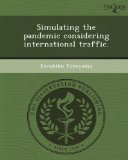書籍
Simulating the Pandemic Considering International Traffic

| 著者名 | Teruhiko Yoneyama |
|---|---|
| 定価 | US$ 69.00 |
| 刊行日 | 2009.09.30 |
| ISBN-13 | 9781244631014 |
| 発売元 | Proquest, Umi Dissertation Publishing |
概要
Pandemics can cause immense disruption and damage to communities and societies. Thus far, modeling of pandemics has focused on either large-scale difference-equation models like the SIR and the SEIR models, or detailed micro-level simulations, which are harder to apply at a global scale. This thesis introduces a hybrid model for the spread of pandemics considering both global infections and local infections. We hypothesize that the spread of an infectious disease between regions is significantly influenced by global traffic patterns and the spread within a region is influenced by local conditions. Thus we model the spread of pandemics considering the connections between regions for the spread of global infections and population and population density based on the SEIR model for the spread of local infections.
We validate our hybrid model by carrying out a number of simulation studies using available data on population, population density, and traffic networks between different regions. We show the power of our approach in both modern and historical contexts. In the modern era, we model the SARS pandemic of 2002-03 and the H1N1 influenza pandemic of 2009- using data on international travel, and demonstrate the close relationship between modern travel networks and the spread of disease. In the historical context, it is difficult to find high-quality travel data. However, we can use data on trade and on troop movements during wars as a proxy for the connectedness of different regions. We use this to model the influenza pandemic of 1918-19 considering the effect of the First World War and the influenza pandemic of 1957-58 considering the effect of the Cold War. We compare our simulation results with the historical record, and find influential factors for the spread of a pandemic. In addition to demonstrating the benefits of our modeling approach for understanding and perhaps in the future mitigating the spread of disease, this methodology also allows us to simulate counterfactual situations. We simulate another historical scenario and find the influence of a historical event upon the spread of a pandemic by comparing the simulation results. Our simulation studies show that international relationships and global traffic patterns significantly influence the spread of pandemics.
本書に関するお問い合せ
ProQuest Dissertation Publishing
TEL:045-342-4780
